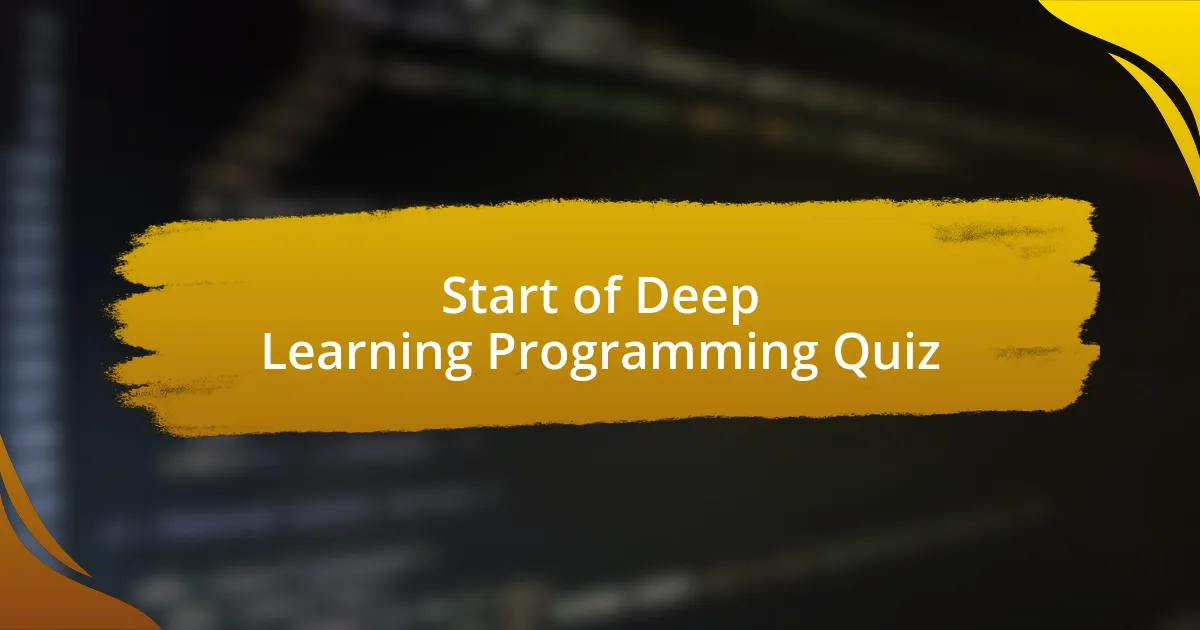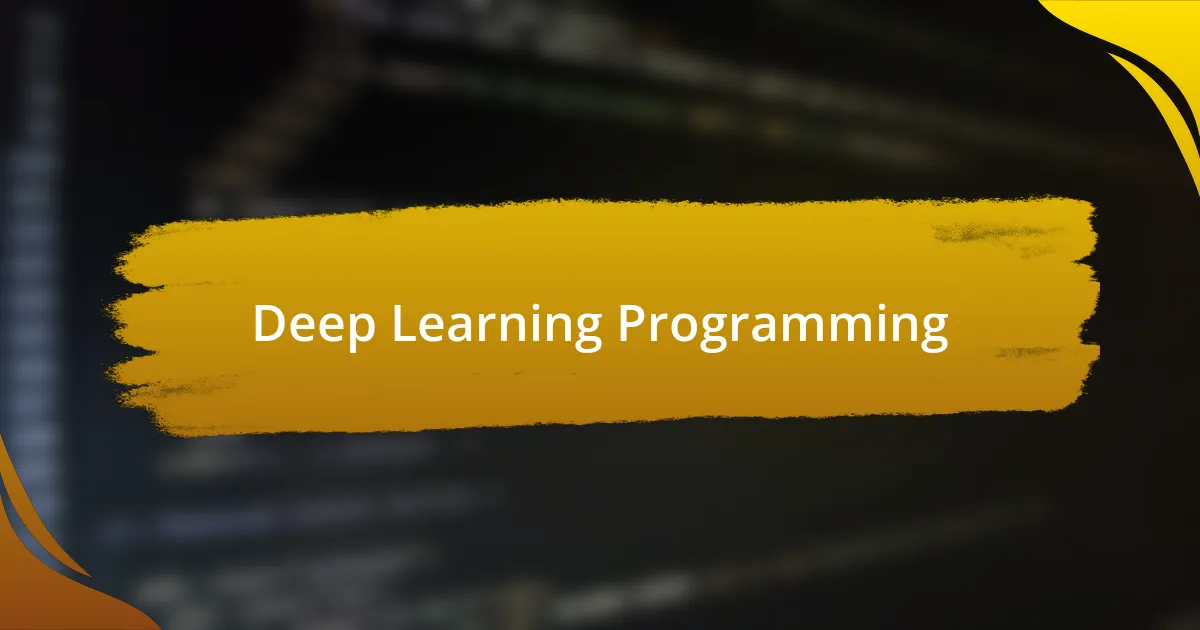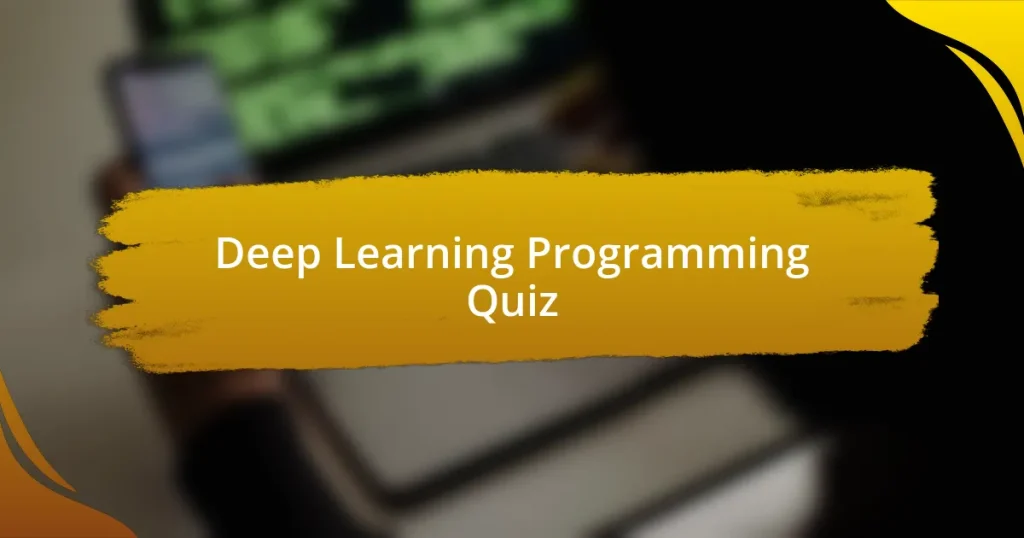
Start of Deep Learning Programming Quiz
1. What is the purpose of activation functions in neural networks?
- Activation functions only output binary values for network predictions.
- Activation functions introduce non-linearity into the model, allowing it to learn complex patterns.
- Activation functions are used to initialize weights in the neural network.
- Activation functions improve the speed of training without changing the model.
2. Explain the concept of overfitting in deep learning.
- Overfitting occurs when a model learns the training data too well, capturing noise and outliers instead of the underlying distribution.
- Overfitting refers to a model that has too few parameters to learn complex patterns.
- Overfitting is when a model generalizes well to new data but fails on training data.
- Overfitting happens when a model performs poorly on both training and test data.
3. What is the role of the learning rate in training deep learning models?
- The learning rate adjusts the amount of data used in each training epoch.
- The learning rate defines the architecture of the neural network.
- The learning rate primarily determines the depth of the model layers.
- The learning rate controls the step size in gradient descent for model training.
4. Describe the difference between batch gradient descent and stochastic gradient descent.
- Batch gradient descent updates weights one sample at a time and stochastic gradient descent uses the entire dataset.
- Batch gradient descent uses the entire dataset for weight updates, while stochastic gradient descent updates weights using one sample at a time.
- Batch gradient descent calculates updates after each epoch and stochastic gradient descent does it after every batch.
- Stochastic gradient descent computes the gradient using the entire dataset, while batch gradient descent uses one sample.
5. What are convolutional neural networks (CNNs) primarily used for?
- Data clustering tasks
- Text generation tasks
- Image processing tasks
- Time series forecasting
6. Explain the concept of transfer learning in deep learning.
- Transfer learning involves using a pre-trained model on a new, similar task.
- Transfer learning requires training a model from scratch without prior knowledge.
- Transfer learning means using a model only for the exact same dataset.
- Transfer learning is the process of translating model weights to a different architecture.
7. What is the purpose of dropout in neural networks?
- Dropout adjusts the learning rate dynamically during training.
- Dropout increases the size of the training dataset through augmentation.
- Dropout enhances model interpretability by providing feature importance scores.
- Dropout prevents overfitting by randomly setting some input units to zero during training.
8. How do recurrent neural networks (RNNs) differ from traditional feedforward networks?
- RNNs use only linear activations for output.
- RNNs are limited to image processing tasks.
- RNNs maintain a hidden state for sequential data.
- RNNs do not handle time-dependent inputs.
9. What is the vanishing gradient problem, and how can it be mitigated?
- The vanishing gradient problem occurs when models overfit training data, causing poor generalization.
- The vanishing gradient problem occurs when the learning rate is set too low, making convergence slow.
- The vanishing gradient problem arises when gradients become too small in deep networks, hindering learning.
- The vanishing gradient problem arises when data is not normalized, leading to erratic gradient updates.
10. What are some common regularization techniques in deep learning?
- LSTM
- Batch normalization
- Max-pooling
- Dropout
11. What is the benefit of using max-pooling in classification convolutional neural networks?
- It combines feature maps from different channels.
- It increases the size of the feature maps.
- It applies normalization to the feature maps.
- It reduces computation and provides more translation invariance.
12. How important is it to shuffle the training data when using batch gradient descent?
- Shuffling is only important when using stochastic gradient descent, not batch.
- It is important to shuffle the training data to ensure diverse mini-batches.
- Shuffling the training data slows down the training process unnecessarily.
- Shuffling the training data is not necessary with any gradient descent method.
13. What is the difference between PyTorch and TensorFlow in terms of their architecture and usage?
- PyTorch is primarily designed for mobile applications, while TensorFlow focuses on web applications.
- PyTorch only supports small datasets, whereas TensorFlow is for large-scale data only.
- PyTorch has a dynamic graph structure, allowing for flexibility and ease of customization, while TensorFlow employs a static graph structure ideal for production settings.
- Both frameworks use the same graph structure and training techniques, making them interchangeable.
14. What are some common evaluation metrics used to assess the performance of deep learning models?
- Sensitivity
- Specificity
- Recall
- Accuracy
15. How do you implement a gradient descent algorithm in deep learning?
- Initialize weights, get outputs, compute error, adjust weights, repeat.
- Start with a model, set thresholds, classify outputs, evaluate performance, conclude.
- Gather data, calculate averages, find max values, print results, finish.
- Organize layers, skip connections, compile data, optimize decimals, visualize graphs.
16. What is the role of batch normalization in deep learning models?
- Batch normalization stabilizes training.
- Batch normalization increases parameters.
- Batch normalization selects features.
- Batch normalization removes data.
17. How does data augmentation enhance the robustness of deep learning models?
- Data augmentation directly improves the model’s architecture.
- Data augmentation techniques artificially increase the size of the training set.
- Data augmentation compresses the training data into smaller formats.
- Data augmentation eliminates the need for training data entirely.
18. What is the difference between L1 and L2 regularization in deep learning?
- L1 regularization adds absolute weight penalty, L2 regularization adds squared weight penalty.
- L1 regularization only applies to biases, L2 regularization applies to inputs.
- L1 regularization shrinks weights equally, L2 regularization increases all weights.
- L1 regularization requires more computation, L2 regularization is faster.
19. How do you handle multi-label classification problems in deep learning?
- Implement one-vs-one classification technique.
- Use binary cross-entropy loss for each label.
- Apply softmax activation for all labels.
- Use a single loss function for all labels.
20. What is the purpose of using recurrent neural networks (RNNs) in natural language processing tasks?
- RNNs perform image classification by analyzing pixel data.
- RNNs capture sequential information for context in language tasks.
- RNNs are used to simplify linear regression equations.
- RNNs speed up the training process of static models.
21. How do you implement transfer learning in a deep learning project?
- Use only the last layer of the model for predictions.
- Load a pre-trained model and fine-tune its weights.
- Train a new model from scratch using random weights.
- Apply data augmentation directly to training data only.
22. What is the vanishing gradient problem in RNNs and how can it be mitigated?
- The vanishing gradient problem occurs when gradients become too small during backpropagation, which hinders learning in RNNs.
- The vanishing gradient problem specifically affects convolutional layers, causing them to fail in image processing tasks.
- The vanishing gradient problem causes model weights to become too large, leading to unstable training.
- The vanishing gradient problem results in slower training by preventing any gradients from updating weights effectively.
23. What is the role of convolutional neural networks (CNNs) in image processing tasks?
- Text generation and translation
- Time series forecasting and analysis
- Image classification and segmentation
- Data normalization and scaling
24. How do you handle class imbalance in deep learning classification tasks?
- Reducing the model complexity
- Using class weights
- Only training on majority class
- Ignoring the minority class
25. What is the difference between batch normalization and layer normalization in deep learning?
- Batch normalization is used for images, while layer normalization is meant for text data.
- Batch normalization normalizes using mini-batches, while layer normalization uses the whole input.
- Batch normalization only works in CNNs, while layer normalization is for RNNs.
- Batch normalization applies the same scale to all layers, whereas layer normalization adjusts per layer.
26. How do you implement early stopping in deep learning training?
- Monitor validation loss and stop training when it doesn`t improve.
- Regularly update the learning rate during training.
- Apply data augmentation to enhance training data.
- Increase batch size to stabilize training performance.
27. What is the role of dropout in preventing overfitting in deep learning models?
- Dropout reduces the learning rate during training to enhance performance.
- Dropout doubles the number of parameters in the model, increasing complexity.
- Dropout randomly sets a fraction of the input units to zero during training, promoting generalization.
- Dropout ensures each neuron is activated in every training iteration for consistency.
28. How do you handle multi-category classification problems in deep learning?
- Use random forest and ensemble methods for each category.
- Limit output to a single label for each training sample.
- In multi-category classification, use softmax activation and one-vs-all techniques.
- Apply only binary cross-entropy loss for every label present.
29. What is the purpose of using recurrent neural networks (RNNs) in time series prediction tasks?
- RNNs only process images efficiently.
- RNNs capture dependencies in sequential data.
- RNNs are used for static data analysis.
- RNNs simplify linear regression models.
30. How do you implement regularization techniques in deep learning models?
- Dropout and L2 regularization
- Using more hidden layers
- Reducing the batch size
- Increasing the learning rate

Quiz Completed Successfully!
Congratulations on completing the quiz on Deep Learning Programming! It’s great to see your commitment to enhancing your understanding of this complex subject. Through this quiz, you’ve likely discovered key concepts like neural networks, frameworks, and optimization techniques. These fundamentals are crucial for unlocking the potential of deep learning in real-world applications.
Participating in this quiz not only tests your knowledge but also reinforces what you know. You may have learned about the intricacies of model training and evaluation, as well as the importance of data preprocessing. Each question has helped clarify these vital components, making you more confident in your deep learning journey.
To further expand your knowledge, we invite you to check out the next section on this page, which dives deeper into the fascinating world of Deep Learning Programming. You’ll find valuable resources, tutorials, and insights that can help you advance your skills. Keep exploring, and continue your learning adventure in deep learning!

Deep Learning Programming
Introduction to Deep Learning Programming
Deep learning programming refers to the development of algorithms that enable machines to learn from large amounts of data. It is a subset of machine learning, which itself is a branch of artificial intelligence. At its core, deep learning mimics the human brain’s architecture through artificial neural networks. Developers use programming languages like Python, R, or Julia alongside libraries such as TensorFlow and PyTorch. These tools facilitate the creation of models that can recognize patterns and make predictions based on information fed into them.
Key Frameworks for Deep Learning Programming
Several frameworks are widely used in deep learning programming. TensorFlow, developed by Google, is renowned for its flexibility and ecosystem, supporting both research and production. PyTorch, created by Facebook, is preferred for its ease of use and dynamic computation graph, making it suitable for research. Keras simplifies building neural networks and is now integrated into TensorFlow. Each framework comes with unique features that cater to different requirements and preferences of developers.
Understanding Neural Networks
Neural networks are the backbone of deep learning programming. They consist of layers of interconnected nodes or neurons. Each layer transforms the input data and passes the output to the next layer. The network learns via backpropagation, adjusting weights based on the error of predictions. This process continues until the model achieves a satisfactory level of accuracy. Insights derived from neural network architectures, such as convolutional neural networks (CNNs) or recurrent neural networks (RNNs), play significant roles in tasks like image and speech recognition.
Training Deep Learning Models
Training a deep learning model involves feeding data into the neural network to optimize its performance. This process requires a well-defined dataset, often split into training, validation, and test subsets. During training, various techniques like mini-batch gradients and dropout are employed to enhance learning efficiency and reduce overfitting. Hyperparameter tuning is also essential, involving adjustments to learning rates, batch sizes, and network depths to find the optimal configuration. The success of the training process directly impacts the model’s predictive capabilities.
Applications of Deep Learning Programming
Deep learning programming has a wide range of applications across various fields. In computer vision, it powers image classification and object detection. In natural language processing, it enables sentiment analysis and language translation. Additionally, deep learning enhances healthcare through predictive diagnostics, improves user experiences in recommendation systems, and contributes to autonomous vehicles through real-time decision-making. The versatility of deep learning makes it essential in advancing technological capabilities in diverse industries.
What is Deep Learning Programming?
Deep Learning Programming refers to the development of algorithms and models that simulate the workings of the human brain to process data. It uses neural networks with many layers, known as deep neural networks, to analyze vast amounts of data. The programming typically involves languages like Python and libraries such as TensorFlow and PyTorch, which are specifically designed for building and training deep learning models. This approach has proven effective in fields like computer vision and natural language processing.
How does Deep Learning Programming work?
Deep Learning Programming works by training neural networks to recognize patterns in data. The process begins with data collection, followed by data preprocessing, where the data is normalized and transformed. Next, models are defined, consisting of multiple layers of neurons that learn to extract features from the data. Training involves adjusting the weights of connections within the network using optimization techniques such as gradient descent, allowing the model to minimize errors. Once trained, the model can make predictions on new, unseen data.
Where is Deep Learning Programming commonly applied?
Deep Learning Programming is commonly applied in various fields, including healthcare for disease diagnosis, finance for fraud detection, autonomous vehicles for object recognition, and entertainment for recommendation systems. Many technology companies deploy deep learning in applications like image and speech recognition, natural language processing, and generative models like GANs (Generative Adversarial Networks), enhancing user interactions and automating processes.
When was Deep Learning Programming first developed?
Deep Learning Programming began gaining traction in the mid-2000s. Notably, a significant breakthrough occurred in 2006 when Geoffrey Hinton and his colleagues introduced the concept of “deep belief networks.” This work laid the foundation for the resurgence of neural networks. By 2012, the field gained further momentum after a deep learning model won the ImageNet competition, achieving unprecedented accuracy in image classification tasks.
Who are the key figures in Deep Learning Programming?
Key figures in Deep Learning Programming include Geoffrey Hinton, often referred to as the “godfather of deep learning,” Yann LeCun, known for his work on convolutional networks, and Ian Goodfellow, who introduced Generative Adversarial Networks. These individuals have significantly influenced the development and popularization of deep learning techniques and have contributed extensively to advancing the field through research and innovation.
















